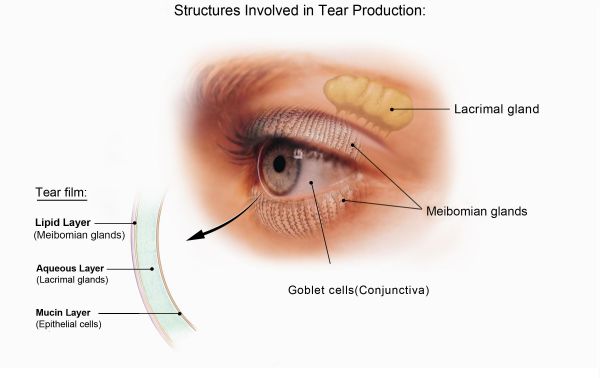Dry eye is a common eye condition causing the eyes to become dry and irritated. Below we explain what causes dry eye and when you should seek treatment.
The normal tear fluid that lubricates the eyes is made up of three layers; an oily (lipid) layer, a watery (aqueous) layer, and a sticky (mucous) layer. These normal tears prevent our eyes from feeling dry.
You release extra tears when you cry. These are the same tears that are also triggered when something goes into or irritates the eye including chopping onions.
People with dry eye either don’t make enough normal (lubricating) tears or the ones that they make are of poor quality, causing the tears to dry up too quickly and the front of the eye to become dry and irritated. As a result, dry eye can be uncomfortable and cause the eye to produce the watery type of tears. This only helps for a short time, leaving the eye uncomfortable and gritty.
If your eyelids are sore and red, you may also have another condition called Blepharitis. Blepharitis is a condition that affects the eyelids making them sore and inflamed. If the eyelid glands become blocked, you may have a condition called meibomian gland dysfunction. It is quite common to have a combination of these conditions.
Dry eye doesn’t tend to cause serious damage to the eyes, but it can be very uncomfortable. Severe cases do have a risk of causing long-term damage, but fortunately, these are rare.

Dry eye is much more common in people over the age of 50. This is often because the glands that make tears, and particularly the oily part of the tears, tend to become less effective as you get older. Also, the tears tend to spread across the eye less well with age.
Some general health conditions can cause dry eye as a side effect, such as autoimmune diseases and hormonal changes. The condition is also more common in windy, cold, dry and dusty conditions.
If you are concentrating on your computer or smartphone for long periods of time without a break, in an air-conditioned or centrally heated environment these can make dry eye worse too, as can some medications and general health problems.
Smoking has also been linked to dry eye as it may both cause the condition and make it worse.
People with dry eye may get some or all of the following symptoms.
Most cases of dry eye tend to be a long-term condition, meaning that you will need ongoing treatment.
There are lots of different types of drops and gels that can help your eyes feel more comfortable. The best ones are preservative-free or contain very gentle preservatives, which helps to reduce irritation. They may also contain an ingredient called sodium hyaluronate, known to be very effective in treating the condition.
It is important to use the correct type of drops for your specific case of dry eye. If your drops aren’t working or you are not sure which drops to use, your local Optometrist can advise you and may be able to offer other treatment options.
Treatment to improve the oily phase of the tears and create a better tear film can also help dry eye. This often involves treating underlying conditions such as meibomian gland dysfunction and blepharitis with hot compresses and eyelid hygiene measures.